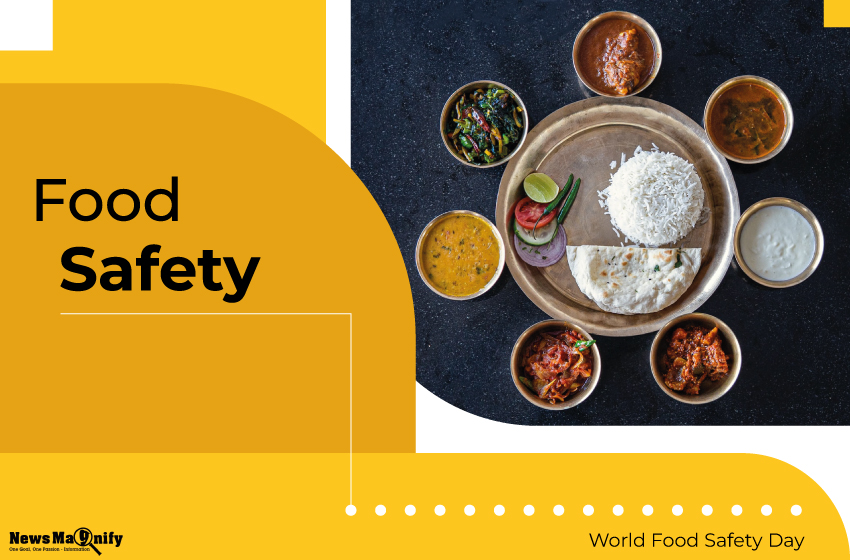
Safety Of Food: Its Importance & Application In Daily Life
- Lifestyle Food
 Swati Merchant
Swati Merchant- June 5, 2022
- 0
- 7 minutes read
Your health depends on what you eat. If you keep up with the safety of food and also a healthy diet, you can enhance your health. In contrast to that, unsafe food practices and foods that are unwholesome lead to serious health problems, just as poor quality of fuel leads to car issues. On this World Food Safety Day, let us go through the various food safety problems and solutions.
According to WHO (World Health Organization),
“Every country in the world is affected by one or more forms of malnutrition.”
This is a term that involves not only undernutrition but also includes conditions like obesity and overweight. Frequent consumption of unwholesome and unhealthy food to carbonated drinks raises the risk of heart disease, diabetes, stroke, and also cancer. According to a report, poor nutrition is the result of at least 11 million deaths in just a year. The World Health Organization anticipates that contaminated foods kill over a thousand people each day and lead to health issues for hundreds of millions causing food safety issues.
Four Key Points To Ensure The Safety Of Foods
Food safety is just some basic thing that we need to maintain. There is no rocket science involved. Ensuring the safety of food is all about doing our regular things a bit more cautiously. Let us have a look at the things that we should maintain for food safety. Also, these points will answer your questions on why is food safety important?
1. Prepare Food Safely
The first food safety tip includes preparing your food safely. We need to prepare our foods safely because dangerous germs in contaminated water and food can enter our system, thus making us sick. Here are some of the expert recommendations that you can follow.
- Before you prepare your food, wash your hands properly with water and soap. Wash your hands for a minimum of 20 seconds. Scrub the backs of your hands, along with between your fingers and also under your fingernails. Wash and dry your hands well.
- Use water and soap for washing cutting boards, dishes, or anything else that is going to touch food. Along with that, avoid using the same board for cutting the foods that will be cooked and the foods that will not be cooked.
- Wash all vegetables and fruits, and also disinfect them if you stay in an area where the crops might have been integrated using water that is contaminated with excrement.
2. Separate Cooked And Raw Foods
Germs excreted from raw foods like meat and also the juices that it releases will contaminate other foods. So it is advisable to never keep those foods together.
- Separate all the raw foods, mainly raw meat from the prepared foods when you carry them home from the supermarket or while you are storing them.
- After you cut your raw meat, wash your hands, the knife, and the cutting board thoroughly before you cut another food.
3. Ensure To Cook Your Food Thoroughly
Harmful germs in the food can only be killed if the food is cooked well at a high temperature.
- Cook the food until it is too hot, the innermost portions of meat must attain 70 degrees Celsius (160°F) for a minimum of 30 seconds.
- Bring the stew and soup to a boil.
- For eating previously cooked food, reheat that until it is hot and is steaming.
4. Keep Food At A Safe Temperature
If food is kept at a temperature between 5 and 60 degrees Celsius (40–140°F) for nearly 20 minutes, the number of bacteria in it can increase further. Along with that, if raw meat is not kept at safe temperatures, some bacteria can release toxins that are not destroyed by cooking.
- Keep your food cold or hot, not lukewarm, to slow or stop germs from growing further.
- Never leave your food sitting at room temperature for over two hours, or for over a one hour if the room temperature is more than 32 degrees Celsius (90°F).
- After the food is being cooked, keep food hot until just prior to serving.
Conclusion
Safety of food implies routine in the handling, preparation, and the storage of food meant for preventing foodborne injury or illness. From factory to the farm to fork, food items may encounter any amount of health hazards at the time of their journey via the supply chain. On this World Food Safety Day, we have discussed the various tips to ensure food safety through our daily chores.

